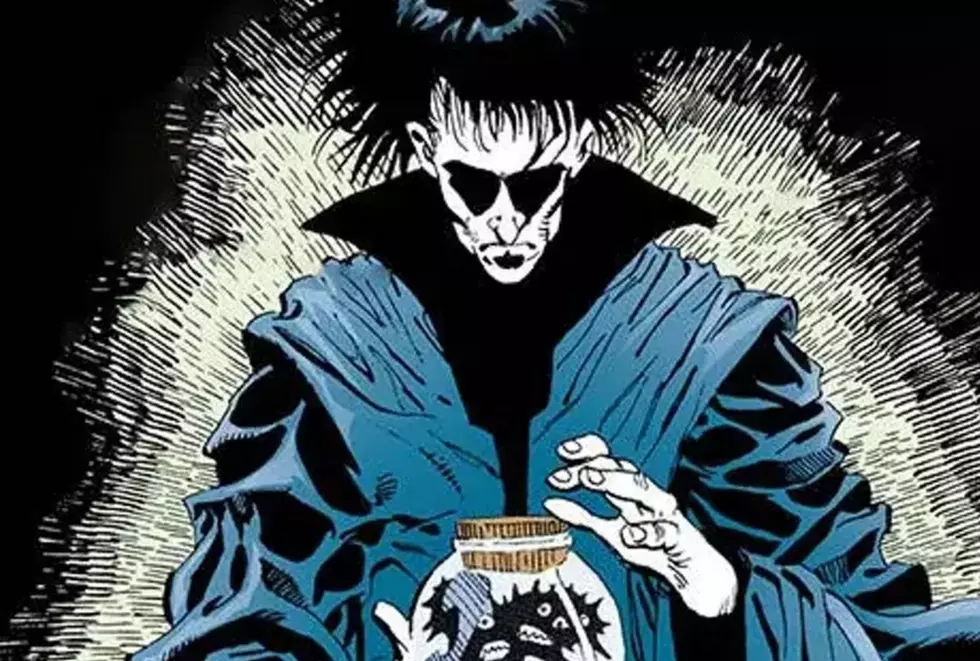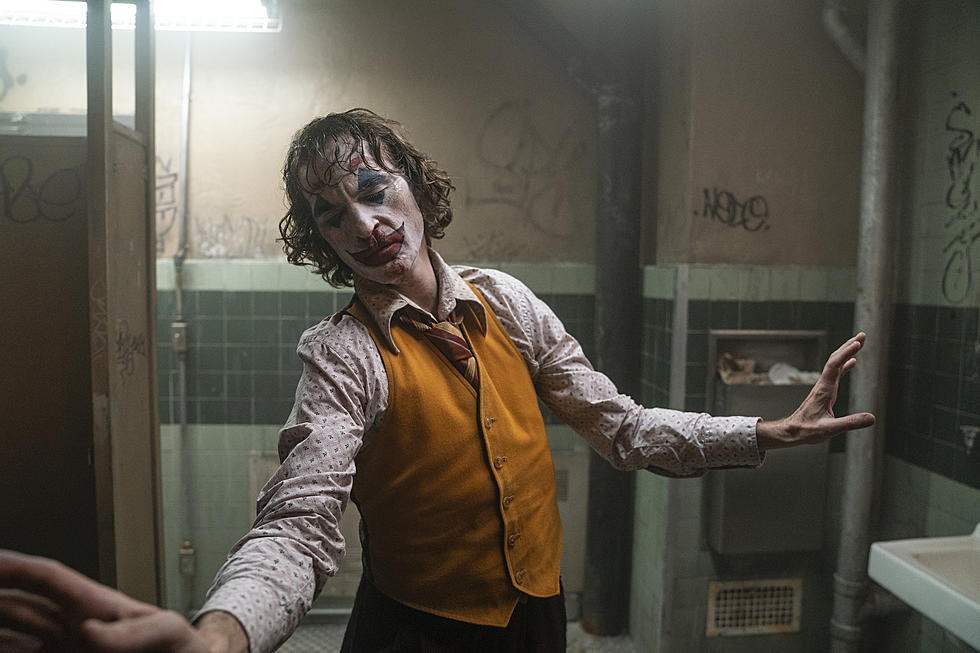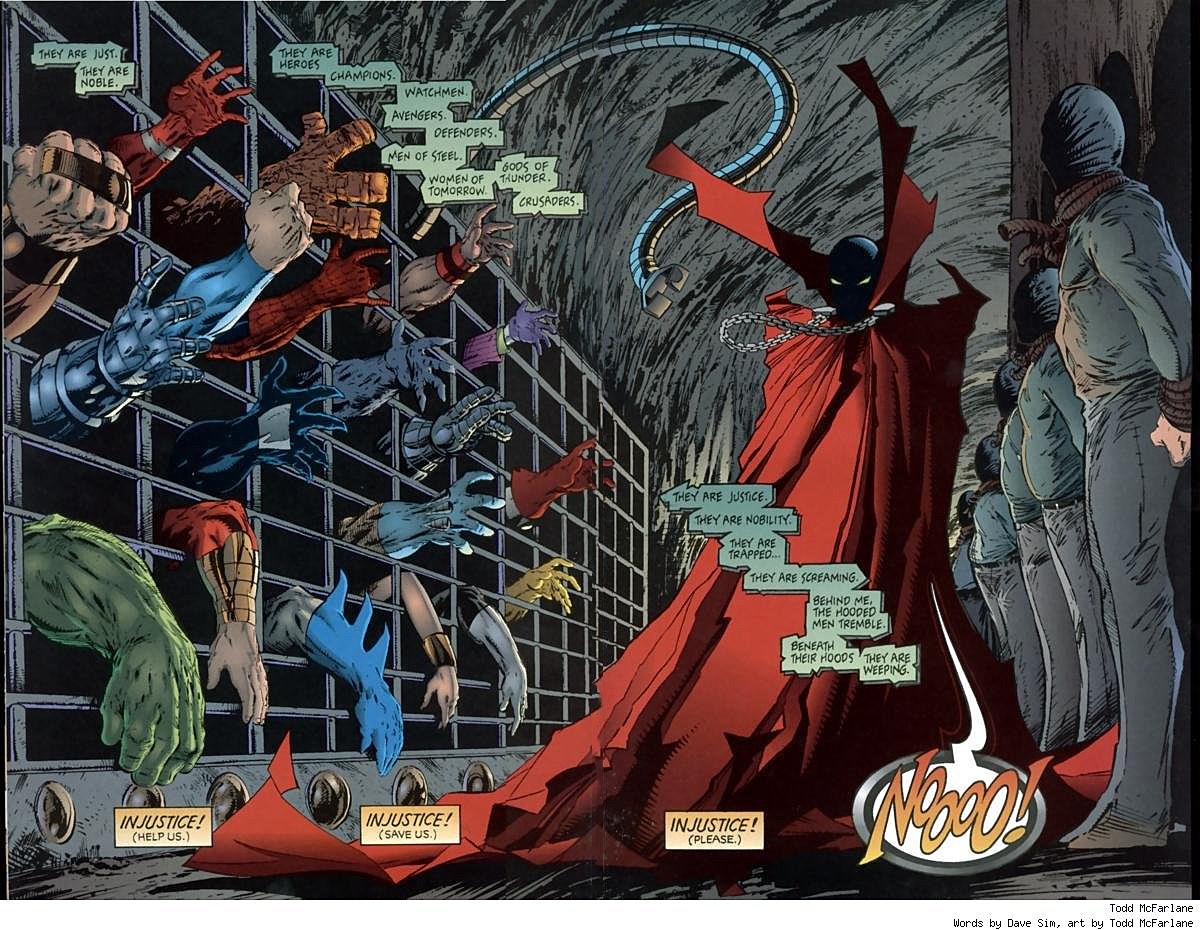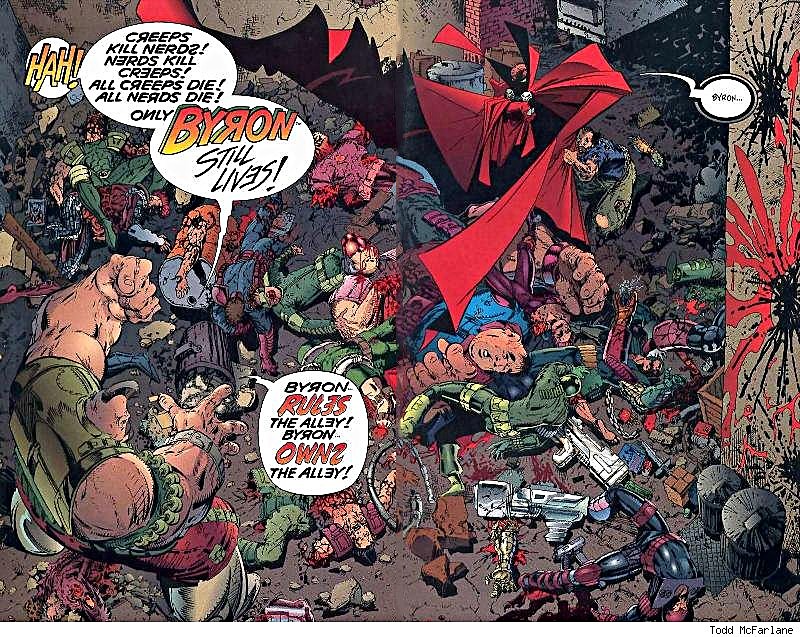
ComicsAlliance Reviews ‘Spawn’ Year One, Part Three: Writertown

Three weeks ago, Image Comics shipped the 220th issue of Spawn, marking 20 years of continuous publication of the supernatural antihero series created by Todd McFarlane. To help commemorate the 20th anniversary of Spawn, ComicsAlliance is embarking on a venture that is every bit as ambitious: a four-part overview of the first "year" of its publication (Being an early Image book, Spawn sometimes shipped late)! In this week's installment, we examine the four classic Spawn issues scripted by superstar guest writers: Watchmen and V for Vendetta's Alan Moore, The Sandman's Neil Gaiman, Cerebus the Aardvark's Dave Sim, and Sin City and Batman: The Dark Knight Returns' Frank Miller.
Roundabouts issue #4 or #5, Spawn carried full-page ads teasing a series of upcoming guest writers. "FRANK MILLER WRITES SPAWN," boasted the first in 168-point type, soon followed by similar proclamations for Alan Moore, Neil Gaiman, and Dave Sim. To a very large portion of readers, this meant pretty much nothing: Spawn's core readership were young, uneducated, comic book fans who were mostly unaware of anything that happened before 1990. Older, more seasoned, better educated readers freaked out: just a few months after its debut, Spawn had nabbed four of the most important, awarded, and respected comics creators of the era. Even back then, if you had arranged all their Eisners and Harveys and Eagle Awards in a row, they would stretch around the earth six times. Look it up.

The guest-splosion began in Spawn #8, penned by the floppy-hair soothsayer Alan Moore, which was a huge get for McFarlane. Moore had effectively retired from superhero comics a few years before, cutting ties with DC (Marvel was out of the equation long before) over issues that have since returned to the forefront and focusing on more personal and esoteric works like From Hell, Big Numbers, and A Small Killing. Somehow, the Toddster was able to coax Moore out of semi-retirement to take another stab at the cape genre. The result is a single-issue tale that seems like it could have been plucked right out of the pages of 2000 A.D.
The ironically-titled "In Heaven" explains what happens to child murderer Billy Kincaid after Spawn's double-dip of justice in issue #5. Rousing from dreams of Spawn coming after him like a wraith, Kincaid wakes inside a Matrix pod of green goo, part of an orchard that houses hundreds -- maybe thousands -- of other after-lifers. Soon Kincaid falls in with others who have broken free from their pods, but of course, the one he's really interested in is Jessica, the little girl who seems to know way more about Hell than she should -- even if her word balloons are yellow.
"In Heaven" is a good story, and a nice re-entrance into genre comics for Moore. It again demonstrated his gargantuan talents for world-building and structure, but like many of his short stories is fairly predictable. Demons of every type pick off the members of Kincaid's group one-by-one, until it's just down to the little girl and "mister chill-ee." When he succumbs to his urges, "Jessica" turns out to be the human-suit for the Vindicator, one of the five Phlebiac brothers along with the previously introduced Violator character. Vindicator then takes Kincaid on a breakneck tour of the ascending spheres of Hell, passing by the seventh, called Erebus, and ending on the eighth sphere, where Kincaid's enlisted into Malebolgia's service as a Hellspawn and engulfed by the same kind of parasitic living costume worn by Al Simmons, which is literally the most frightening thing Kincaid's ever seen. The issue is good pop storytelling that undoubtedly raised the literary value of the Spawn title.

That trend continued with issue #9, which had a lot to offer: Neil Gaiman, a new glossy paper stock, three new characters, and over a decade of legal battles concerning ownership of its contents and spin-offs. If you don't know everything about that, you can learn about it in lots and lots and lots of places. How was the actual comic book? Pretty good. Like everything Gaiman writes, it's done with his inimitable voice and spin on mythology. Opening in the 12th century, Gaiman and McFarlane introduce two of "the properties in question" -- Angela and Medieval Spawn -- with the nifty device of an angel's text explaining how to stalk and kill Hellspawn. In a hierarchy of angels that's run like a Fortune 500, Angela is part of an order of Valkyrie-like freelance Spawn hunters who do the dirty work of taking out Malebolgia's potential officers. Angela makes quick work of Medieval Spawn.

Meanwhile, in shantytown, Al comes to know his homeless friends a little better, including a long-bearded bald man in a toga who refers to himself as Count Nicholas Cogliostro. This guy knows Spawn's real name, his role in the grand scheme, and teaches him how to create cheap liquor out of thin air. Before Cogliostro can explain how he knows all of these things, Angela appears and pot-shots Spawn, but finds former mercenary Al Simmons a tad more difficult than Sir Lanced-a-lot. Al sends her screaming back to Heaven before making the rookie mistake of touching an angel's lance, which weirdly blinks him off to another plane of existence. Even weirder: McFarlane uses negative space.
The best thing about the story is Spawn's relationship with the homeless he camps with. McFarlane kept trying but hadn't made any good points about their dynamic, but Gaiman nailed it down -- they were all just guys down on their luck. They accepted Al and protected him, just as he protected them, because every one of them knew what it was like to live a better life. Another well-written issue that articulated corners of Spawn's world that McFarlane had a little trouble with.

The Dave Sim-written issue #10 provided a much bigger picture of Spawn's world. The Cerebus creator had little interest in Spawn, The Violator, or anything else that would later sell toys. What Sim was interested in was what McFarlane represented -- a highly successful comic creator who owned his own character. When Spawn touched Angela's lance, he zapped himself right into meta-fiction, where Sim's Cerebus makes Spawn aware that he is a creation and, in part, his creator; and that Erebus, the seventh level of Hell seen in the previous issue, is a prison for licensed superhero characters and the creators who gave them up. And it's much better than it sounds. The image of the prison cell, with several heroes' arms sticking between the bars, is one of the most enduring of early Spawn.
Sim has always possessed an ability to write about mundane things at a magical level; he breaks the fourth wall and stretches into meta-fiction more naturally than several of comics many practitioners. Issue #10 is an Imaginary Tale about real things -- creators' rights, making a living in the industry -- that somehow ends like a romance comic, with Spawn (McFarlane) snuggled in his giant home with his wife and daughter, and a big, juicy "Spawn is trademark and copyright Todd McFarlane...Forever." Aww.

But who needs that kinda crap when you have Frank Miller to explode your Commie insides? For issue #11, the man himself, McFarlane's unabashed big crush, stomped into Spawn and dragged readers back from all the flowery British and otherwise non-American planes of existence into the mutated neon wasteland that they all deserved. Spawn awakes in the alleyway, where everything he just experienced feels like a dream, and a high-tech gangwar just kinda pops up out of nowhere. It turns out that Al's alleyway is a prime piece of real estate in a war between the Creeps and the Nerds.
Yes, the Creeps and the Nerds. It gets more awesome. The Creeps and the Nerds are armed with high-tech military weapons and cyborgs and straight-edge clean and sober. "White middle class computer geek street gangs," Miller's Batman-voiced exposition points out. Thinking back to his military training, Spawn creates an opportunity for the gangs to wipe each other out. When only one Creep is left -- the cyborg Byron -- Batman Spawn says, "let's play Alien," teleports inside Byron's chest and rips his way out through Byron's stomach.
Mission accomplished: readers taken back to status quo and over-the-top violence; Commie insides exploded.
Next week in our final installment: Who killed Spawn?

More From ComicsAlliance











